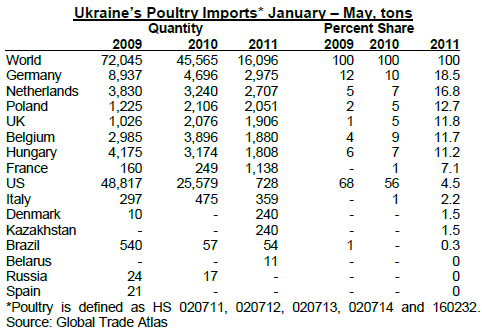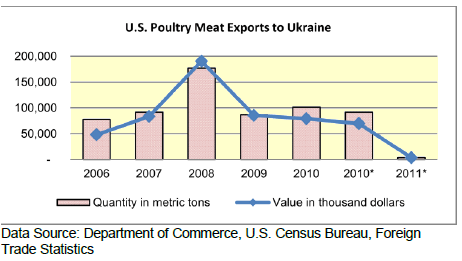



International Egg and Poultry Review: Ukraine
UKRAINE - Ukraine’s poultry industry has grown steadily and is expected to reach 880,000 metric tons in 2012, according to the USDA's Agricultural Marketing Service (AMS).Poultry producers benefit from low labour and feed costs and favourable tax regimes. Poultry imports are restricted by the necessity to obtain import permits and by Customs officers valuing goods above their true value, thereby raising customs duties and value added tax owed. Broiler meat imports began trending downward 2008 while exports increased; in 2012 Ukraine is forecast to become a net exporter.

Ukraine’s poultry industry is concentrated with the three largest producers controlling 72 to 75 per cent of the market. Major poultry producers are looking at a three to five year investment horizon and are investing in broad vertical integration and risk mitigation, including new production and storage facilities, processing facilities for semi-cooked poultry products, feed mills, agricultural machinery and other inputs. Producers are also investing in arable land acquisitions (rent titles) to produce feed crops and moderate future price fluctuations. There is a moratorium on selling agricultural land so producers cannot buy land.

Prior to 2011, frozen imported US poultry was sold for further processing to Ukrainian sausage, smoked products and bologna makers. Domestically produced chilled poultry (whole and parts) was mostly marketed into retail channels and only partially met the demand of processors for cheap meat. Whole chickens from Brazil could not compete and were priced out of the market. US chicken leg quarters were priced under Ukrainian product and were in indirect competition due to different market segments. As Ukraine faced increased domestic production and limited export opportunities, domestic producers turned to domestic low-margin segments and are currently aimed at the leg quarter market.
The EU supplies the lowest market segment with mechanically deboned meat. So far the Ukrainian industry finds this segment unattractive, but this is likely to change as Ukraine increases its parts exports.

Major Ukrainian poultry producers started expanding foreign markets three to four years ago. Kazakhstan and Moldova became the top markets for poultry meat; Viet Nam and Hong Kong became the major markets for chicken paws. Exports to Russia are limited since only a few facilities are approved. There is potential since Ukraine can supply Russia with higher quality chilled products and the two countries have an FTA that keeps Ukrainian poultry outside of Russian import quotas.
The most recent inspection conducted by Rosselkhoznadzor was officially positioned as Custom Union (CU) Inspection. This means that all restrictions imposed will automatically be accepted by CU countries, including Kazakhstan. About 50 per cent of Ukraine’s poultry meat exports go to Kazakhstan, making the poultry industry dependent on import demand in Kazakhstan and the political situation in the Custom Union. Ukraine has formal Free Trade Agreements with most Former Soviet Union (FSU) countries that provide Ukrainian poultry with some trade protection.

The industry did not reach agreement but has announced market access negotiations with United Arab Emirates and Saudi Arabia. Ukraine is in negotiations with the EU for a deep and comprehensive free trade agreement as part of a future Association Agreement. Ukraine would like to have an 80,000-ton zero duty export quota, while the EU is only offering a 10,000-ton quota due to Ukraine’s inability to fill an 80,000-ton duty. If negotiations last a while longer, Ukrainian poultry producers will be able to cancel this argument.
Source: USDA/FAS; USTR; European Commission; news wires
Further Reading
| - | You can view the full report by clicking here. |








